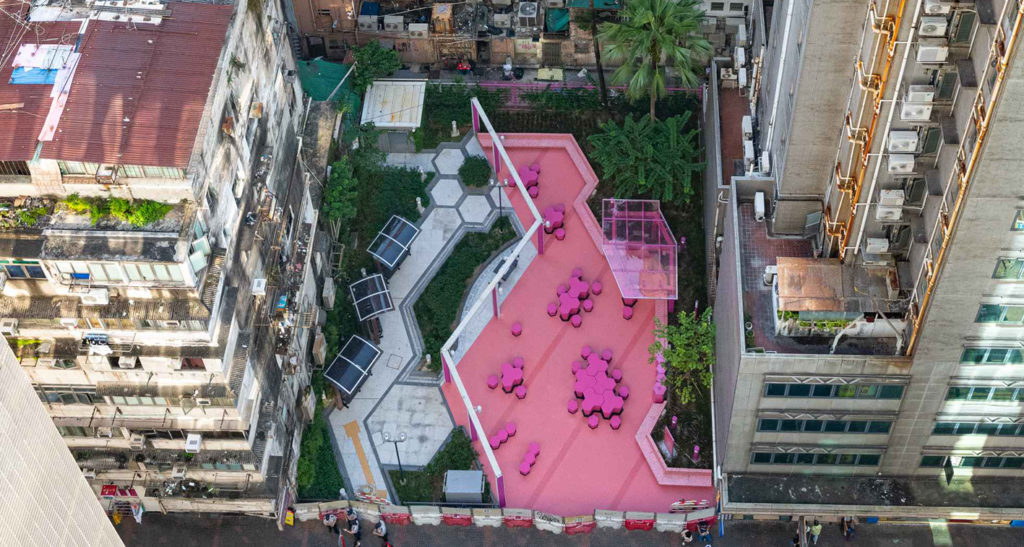Minding the gap: a vibrant rest garden between city buildings
November 5, 2021

The micropark sits within a dense urban area. Photo courtesy of Design Trust
Portland Street is one of the most popular streets in the Kowloon Peninsula, Hong Kong, known for its various retailers, bazaars, local restaurants and hourly hotels. Located in the Yau Ma Tei area, it has a long history as a harbour village that lives on to this day—including a century-old fruit market, a 1930s theatre, a temple complex and other heritage public buildings. Through the years, Yau Ma Tei has grown as a large-scale mixed-use development, comprising some of the tallest buildings in Hong Kong.
Due to its rapid development, the district has the highest population density in the country. Portland Street Rest Garden is designed as an important leisure spot for the community, surrounded by residential blocks with an array of neighbourhood shops on the ground level. FuturArc spoke to Design Trust, an initiative of the Hong Kong Ambassadors of Design, about this vibrant micropark amidst the towers.
Q: What constraints were found at the existing site and how did the project team overcome them? What design features highlighted those efforts?
A: The major users at Portland Street Rest Garden were mainly adults and the elderly, including many long-time residents of the area. People’s typical routines at the garden include resting, smoking, waiting for transport, or reading horse racing newspapers, especially on race-days. However, issues such as garbage, debris and odour were found within the perimeter. The garden was often crowded on horse racing days, where most seats were occupied—leaving many users to sit on the curbs and ground.
Noting the majority age group of the park users, the team envisioned a thoughtful approach to incorporate existing elements from the site—such as the steel frames—while injecting new energy through the design. To blend the old and new, this ‘Half Park’ concept features one half of the area with restored and renewed furniture and facilities from the original layout, and the other half with a playful and contemporary ambiance from the fuchsia tone, creating a sharp visual identity.
The renewed Portland Street Rest Garden is now a multifunctional open space for different community users. Through the movable furniture system and new benches, the number of seats has increased from 16 to a maximum of 81, while the tables have increased from two to 12, providing more usage possibilities in the park.
Q: How does the project impact the local community? Does it involve the participation of the local community in terms of the design and/or construction; or factor in their livelihoods?
A: Throughout the design process, the team has engaged with various stakeholders and public agencies including government departments such as the Architectural Services Department (ArchSD) and Leisure and Cultural Services Department (LCSD), district councils, local non-governmental organisations, residents of the district and the general public. Their ideas were considered, beginning from site analysis to concept design and technical development.
In the satellite event of the Portland Street Rest Garden Prototype Display, visitors of the park were encouraged to engage and test the moveable furniture. A survey was also handed out to record the user experience, focusing on usability, material, comfort, durability and colour, with discussions on usage and ergonomics.
Q: How does this project take into account the immediate surroundings in terms of its design? What is the impact of the project on the surrounding landscape?
A: Taking into account the abovementioned challenges of the original site, the design team utilised a ‘climber wall’ at the back of the garden planted with jasmine flowers for a more olfactorily pleasant experience. The landscape strategy brought together two new trees, a selection of climber plants and bamboos alongside pink-toned flowers—such as fire bougainvillea and Pennisetum setaceum or rubrum—to achieve a higher density of greenery from 30 to 38 per cent, a pleasant sensory environment, and lively energy in the dense neighbourhood.
To resolve the issue of insufficient seating areas for the community, the design team used terrazzo materials for the seats, providing smooth and refined surfaces. Terrazzo is one of the most durable materials available today—once sealed properly, the material becomes impervious to water and stain damage. Terrazzo is an environmentally-friendly material [due to its durability; low embodied energy; as well as being composed of VOC-free and recycled materials].
Garbage was also an existing problem on the site. Thus, it is important to promote waste reduction while enhancing visitors’ experience with new recycle bins installed in the park to separately collect waste paper, metals and plastics. The team designed these recycle bins with signage in bright pink colours, creating a cohesive visual identity across the site. A new drinking fountain with a bottle-filler device has also been installed in the park. Visitors are encouraged to bring their own bottles to refill with drinking water, reducing single-use plastics.
PROJECT DATA
Project Name
Design Trust Futures Studio – Portland Street Rest Garden
Location
Portland Street, Yau Ma Tei, Hong Kong
Completion Year
September 2021
Site Area
376 square metres
Client/Owner
Leisure and Cultural Services Department (LCSD), HKSAR Government
Architecture Firm
Architectural Services Department (ArchSD), HKSAR Government
Images/Photos
Design Trust
Read more Cities projects below:
To read the complete article, get your hardcopy at our online shop/newsstands/major bookstores; subscribe to FuturArc or download the FuturArc App to read the issues.

